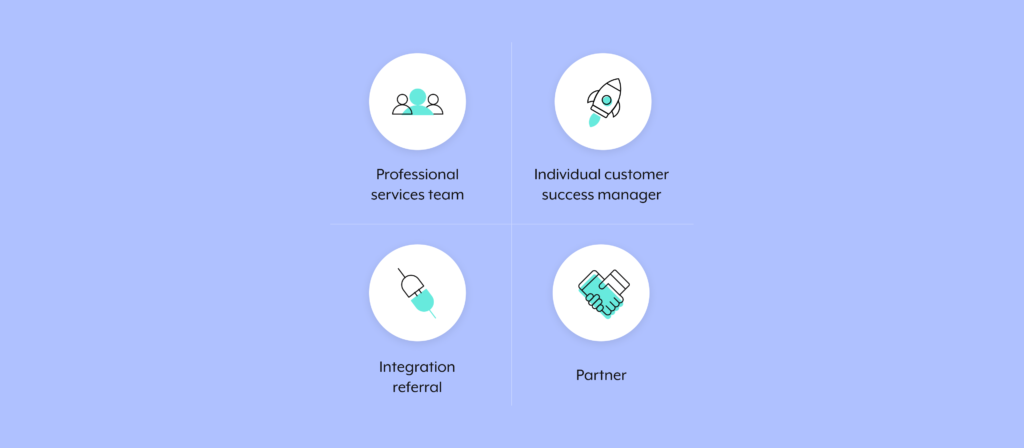The fastest-growing SaaS businesses likely have a variety of factors influencing their momentum.
They have a strong product-market fit. They have high-performing sales reps. And, as it turns out, they have a myriad of product integrations that allow clients to use their apps with others.
According to research by Pandium, the 1,000 fastest-growing SaaS businesses have, on average, 98 product integrations built out; and several of these organizations have taken in excess of 500 integrations to market.
The path you choose for implementing these product integrations, however, can lead to drastically different results, both for your business and your clients.
To help you evaluate your options, we’ll cover common approaches that work outside of your product; we’ll then make the case for why your business needs an embedded platform instead.

How to tackle your integration backlog
We analyzed the roadblocks that 200 product managers faced when attempting to tackle their integration backlogs. Learn which stood out as well as how you can solve for them.
1. Customer success
This consists of customer success managers implementing ad hoc integration and automation solutions via a tool that offers fairly basic functionality.
Pros:
- It can be a relatively inexpensive solution, as the tool may come at a low price point and the CSM can operate independently.
- It may be easy to convince customers to invest in this solution if it’s a one-off and it comes at a low additional cost.
- Your customers’ unique integration needs can be addressed quickly, leaving customers satisfied with your CSM team.
Cons:
- Since CSMs are solving for integration requests from each customer, this approach is impossible to manage at scale.
- Your CSMs are forced to move away from their core responsibilities and the value-add activities that are more likely to create a meaningful partnership—which, over time, translates to higher customer retention and more upsells/cross-sells.

Related: Comparing build vs buy across a range of considerations
2. Professional services
Simply put, this is when a customer hires your in-house professional services (PS) team to implement and maintain integrations and automations involving your product. Your PS team may bill by the hour or on a project-by-project basis.
Pros:
- Your professional services team can tailor the integrations and automations to the individual use cases of clients—allowing clients to maximize the value from your product.
- The team is highly knowledgeable of your product, which can help them in implementing integrations and automations efficiently. In addition, their expertise and experience enables them to assist clients in identifying the most impactful product integrations.
Cons:
- Your PS team will be forced to grow alongside clients’ demand for integrations and automations, which likely isn’t scalable for your organization.
- Reps will need to be trained on selling your professional services. At the same time, your PS team will need to learn about the various systems that your customers want to integrate your product with.


Ready to implement product integrations at scale?
Learn how Workato’s modern embedded iPaaS lets you build integrations to your product in a matter of minutes.
3. Partners
These are 3rd-party companies that can implement the integrations and automations on behalf of the client. Like PS, they can bill the client either by billable hours or by the number of projects they work on.
Pros:
- They have a comprehensive understanding of your software landscape and they may be able to use specific iPaaS solutions effectively.
- They may have experience with integrating a wide range of apps, which can lead them to offer an independent perspective on best practices in connecting your app to other apps or creating automations.
Cons:
- They lack expertise both in your product and in the market problems your app solves. This can prevent them from working efficiently to provide clients with a solution.
- The client is forced to deal with another vendor—and all of the work that entails.

4. Integration referrals
Your business development team finds a 3rd-party integration solution that you can refer to clients.
Pros:
- There’s little effort required by your team, as the third-party vendor and your customer work together after your introduction.
- There are no additional sales ops, finance, and enablement considerations to be managed long-term.
Cons:
- Like with partners, your clients have to engage with and manage another vendor.
- Also similar to partners, your clients miss out on your team’s unique perspective on and approach to solving the market problems your software tackles.
- The client may have to learn how to use the tool on their own.
Related: What is an embedded integration platform? And why is it worth investing in?
Common drawbacks to these approaches
Despite each of these options having their own set of pros and cons, they fail to answer a common set of issues:
1. Product gap: Your customers have to work outside of your app to get their integration and automation needs addressed. This means your product team is missing out on solving a common customer pain in-product that could provide immense value, impact, and satisfaction.
2. Difficult to scale: Your clients want and need to integrate your app with numerous others to have it fit seamlessly into their workflows. Each of the approaches above, however, makes this demand unnecessarily difficult to tackle, both from a cost and resource perspective.
3. Missing data: Out-of-product integrations and automations prevent your team from seeing which integrations are utilized and by whom. Your product team’s ability to analyze this type of product usage data, therefore, gets compromised—in turn, limiting their capacity to decide on new features and functionalities they prioritize.
4. Uncaptured revenue: With the exception of PS, these approaches leave revenue on the table, as clients are implementing integrations and automations elsewhere.
Fortunately, Workato’s Embedded Platform—which allows you to embed our iPaaS directly into your product—lets you avoid these issues entirely, while driving product-led growth.
